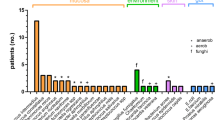Summary
Successful clinical outcomes are not achieved in all patients who undergo image-guided stereotactic surgery as the initial procedure in the management of brain abscess. We sought to define those factors related to management failure, so that the initial surgical approach could be selected using preoperative clinical or imaging criteria. We reviewed our twelve-year experience in 29 consecutive patients. Twenty-two (76%) patients had drainage of abscesses with purulent centers. Seven (24%) underwent lesion biopsy for diagnosis. Twelve patients (with abscesses >3 cm in average diameter) underwent stereotactic insertion of drainage catheters. Ten patients (34%) had adverse risk factors including immunologic suppression after prior organ transplantation, chronic steroid therapy, prior antineoplastic chemotherapy, or retained foreign body. Microbiological identification of the causative organism was obtained in 22 patients; 6 patients had positive Gram stains without growth in culture (bacteriological diagnosis=97%). Long-term clinical evaluation (up to 8.5 years, median 3 years) confirmed disease resolution after initial single-procedure stereotactic management in 21 patients (72%). Eventual abscess resolution occurred in an additional 6 patients (21%), all of whom required multiple procedures. Five patients died of complications of their systemic disease during the follow-up period. Fifteen of the 18 (83%) surviving patients who had no associated risk factors returned to their premorbid functional capacity. Factors associated with initial treatment failure included inadequate aspiration, lack of catheter drainage of larger abscesses, chronic immunosuppression, and insufficient antibiotic therapy.
Similar content being viewed by others
References
Apuzzo MLJ, Chandrasoma PT, Cohen D, Zee CS, Zelman V (1987) Computed imaging stereotaxy: Experience and perspective related to 500 procedures applied to brain masses. Neurosurgery 20: 930–937
Apuzzo MLJ, Sabshin JK (1983) Computed tomographic guidance stereotaxis in the management of intracranial mass lesions. Neurosurgery 12: 277–285
Bellar AJ, Sahar A, Praiss I (1973) Brain abscess. Review of 89 cases over a period of 30 years. J Neurol Neurosurg Psychiatry 36: 757–768
Broggi G, Franzini A, Peluchetti D (1985) Treatment of deep brain abscesses by stereotactic implantation of an intracavitary device for evacuation and local application of antibiotic. Acta Neurochir (Wien) 76: 94–98
Coffey RJ, Lunsford LD (1985) Stereotactic surgery for mass lesions of the midbrain and pons. Neurosurgery 17: 12–18
Dandy WE (1926) Treatment of chronic abscess of the brain by tapping: preliminary note. JAMA 87: 1477–1478
Dyste GN, Hitchon PW, Menezes AH, VanGilder JC, Greene GM (1988) Stereotaxic surgery in the treatment of multiple brain abscesses. J Neurosurg 69: 188–194
Flewett TH (1973) The rapid diagnosis of herpes encephalitis. Postgrad Med J 49: 398–400
Gleason CA, Wise BL, Feinstein B (1978) Stereotactic localization (with computerized tomographic scanning), biopsy, and radiofrequency treatment of deep brain lesions. Neurosurgery 2: 217–222
Goodman ML, Coffey RJ (1989) Stereotactic drainage of aspergillus brain abscess with long-term survival: Case report and review. Neurosurgery 24: 96–99
Gortvai P, De Louvois J, Hurley R (1987) The bacteriology and chemotherapy of acute pyogenic brain abscess. Br J Neurosurg 1: 189–203
Hall WA, Martinez AJ, Dummer SJ, Lunsford LD (1987) Nocardial brain abscess: diagnostic and therapeutic use of stereotactic aspiration. Surg Neurol 28: 114–118
Hall WA, Martinez AJ, Dummer SJ, Lunsford LD (1989) Central nervous system infections in heart and heart-lung transplant recipients. Arch Neurol 46: 173–177
Hollander D, Villemure J-G, Leblanc R (1987) Thalamic abscess: A stereotactically treatable lesion. Appl Neurophysiol 50: 168–171
Itakura T, Yokote H, Ozaki F, Itatani K, Hayashi S, Komai N (1987) Stereotactic operation for brain abscess. Surg Neurol 28: 196–200
Jooma OV, Pennybacker JB, Tutton GK (1951) Brain abscess: aspiration, drainage or excision? J Neurol Neurosurg Psychiatry 14: 308–313
Leksell L (1949) A stereotaxic apparatus for intracerebral surgery. Acta Chir Scand 99: 229–233
Lunsford LD (1987) Stereotactic drainage of brain abscesses. Neurol Res 9: 270–274
Lunsford LD, Coffey RJ, Cojocaru T, Leksell D (1990) Imageguided stereotactic surgery: a 10-year evolutionary experience. Stereotact Funct Neurosurg 54 + 55: 375–387
Lunsford LD, Levine G, Gumerman LW (1985) Comparison of computerized tomographic and radionuclide methods in determining intracranial cystic tumor volumes. J Neurosurg 63: 740–744
Lunsford LD, Martinez AJ, Latchaw RE (1984) Rapid and accurate diagnosis of herpes simplex encephalitis with computed tomography stereotaxic biopsy. Surg Neurol 21: 249–257
Lunsford LD, Nelson PB (1982) Stereotactic aspiration of a brain abscess using the “therapeutic’ CT scanner. A case report. Acta Neurochir (Wien) 62: 25–29
Lunsford LD, Parrish R, Albright AL (1984) Intraoperative imaging with a therapeutic computed tomographic scanner. Neurosurgery 15: 559–561
Mundinger F, Birg W, Klar M (1978) Computer-assisted stereotactic brain operations by means including computerized axial tomography. Appl Neurophysiol 41: 169–182
Nagle RC, Taekman MS, Shallat RF, Cohen R (1986) Brain abscess aspiration in nursery with ultrasound guidance: case report. J Neurosurg 65: 557–559
Nauta HJW, Contreras FL, Weiner RL, Crofford MJ (1987) Brain stem abscess managed with computed tomography-guided stereotactic aspiration. Neurosurgery 20: 476–480
Rosenblum ML, Hoff JT, Norman D (1978) Decreased mortality from brain abscesses since the advent of computerized tomography. J Neurosurg 49: 658–668
Rosenblum ML, Hoff JT, Norman D (1980) Non-operative treatment of brain abscesses in selected high-risk patients. J Neurosurg 52: 217–225
VanGilder JC, Allen WE III, Lesser RA (1974) Pontine abscess: survival following surgical drainage: case report. J Neurosurg 40: 386–390
Vaquero J, Cabezudo JM, Leunda G (1980) Nonsurgical resolution of a brain-stem abscess: case report. J Neurosurg 53: 726–727
Vincent C (1936) Sur une methode de traitement des absces subaigus des hemispheres cerebraux: large decompression, puis ablation en masse sans drainage. Gaz Med Fr 43: 93–96
Wise BL, Gleason GA (1979) CT-directed stereotactic surgery in the management of brain abscess. Ann Neurol 6: 467
Author information
Authors and Affiliations
Rights and permissions
About this article
Cite this article
Kondziolka, D., Duma, C.M. & Lunsford, L.D. Factors that enhance the likelihood of successful stereotactic treatment of brain abscesses. Acta neurochir 127, 85–90 (1994). https://doi.org/10.1007/BF01808553
Issue Date:
DOI: https://doi.org/10.1007/BF01808553




